Original Author: Lorenzo Valente
Original Translation: Luffy, Foresight News
In ARK's "Big Ideas 2025" report, we provide investors with deep insights into the cryptocurrency asset space, including stablecoins. Since January of this year, the supply of stablecoins has surged by 20% to $247 billion, exceeding 1% of the U.S. M2 money supply. Tether and Circle continue to dominate the market with scales of $150 billion and $61 billion, respectively, accounting for over 85% of the total market share.
We believe that stablecoins could become one of the most important strategic assets for the U.S. government in the next 5-10 years. Why is that? Over the past 15 years, the proportion of foreign holdings of U.S. Treasury bonds has sharply declined, and this trend may continue given the evolution of geopolitical pressures. Meanwhile, the Federal Reserve is unlikely to increase its purchases of U.S. Treasuries due to its ongoing quantitative tightening.
We believe the stablecoin market will experience exponential growth, with supply expected to increase 5-10 times over the next five years. This expansion could push demand for U.S. Treasuries to levels previously supported by sovereign nations. Additionally, stablecoins are covering areas and populations that the traditional banking system has failed to serve, offsetting the current wave of de-dollarization.
We elaborate on the arguments and analysis of stablecoins in six parts:
Demonstrating the historical decline in holdings of major foreign holders of U.S. Treasuries;
Arguing that macroeconomic dynamics (including geopolitical changes) have reduced these countries' interest in investing in U.S. Treasuries;
Describing how stubborn inflation reduces the likelihood of large-scale bond purchases by the Federal Reserve in the short term;
Explaining how stablecoins fill the demand vacuum left by historical major holders of U.S. Treasuries;
Illustrating how stablecoins backed by U.S. Treasuries can act like a "Trojan Horse" to facilitate trade and bring dollars back into U.S. Treasuries;
Arguing that stablecoins have significantly enhanced the global dominance of the U.S. dollar.
The U.S. government is losing its largest bond buyers
In 2011, among $10.1 trillion in outstanding U.S. Treasuries, China, Japan, and Canada accounted for 12.9%, 8.7%, and 1.43%, respectively, totaling 23%. As of November 2024, among $36 trillion in outstanding U.S. Treasuries, the holdings of these three countries have dropped to 2.14%, 3.05%, and 0.95%, respectively, totaling about 6%, as shown in the table and chart below:
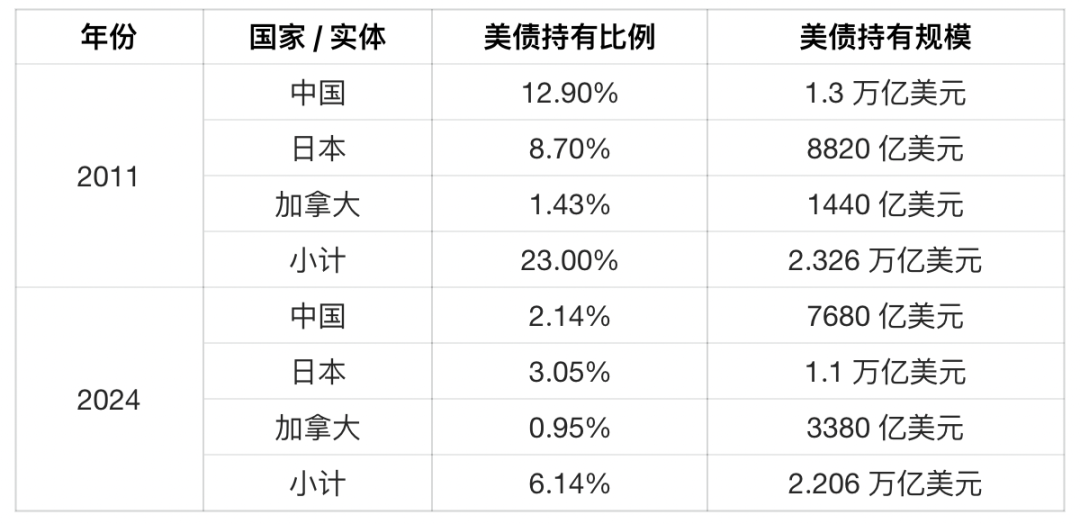
Data Source: ARK, as of May 15, 2025
It is important to reiterate that in just about 13 years, the proportion of holdings by the largest creditor of U.S. Treasuries has plummeted from 23% to 6%, as detailed below:
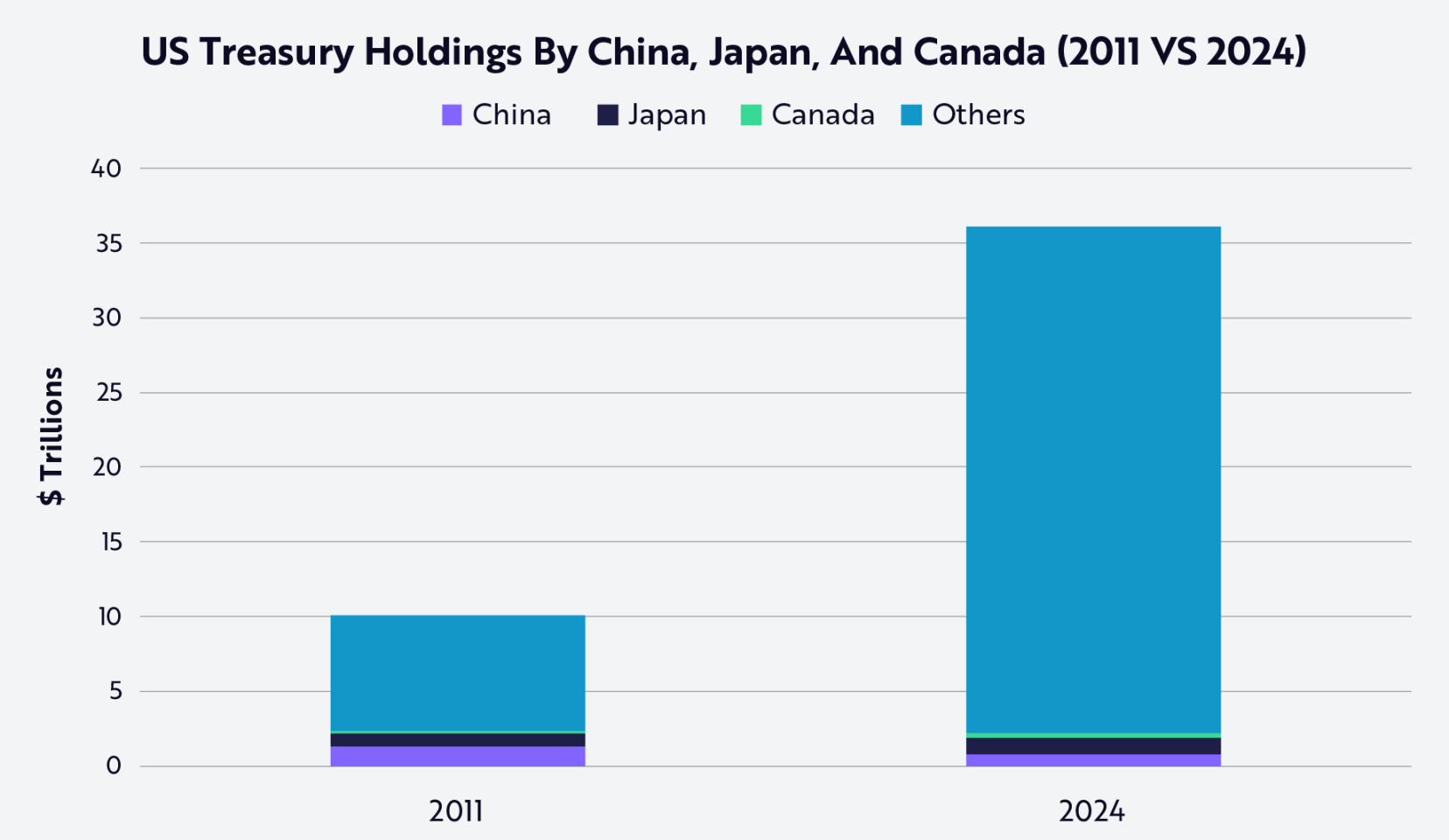
Data Source: ARK, as of May 15, 2025
What happened?
Historically, China accumulated dollars through massive trade surpluses and purchased U.S. Treasuries, primarily motivated by the desire to control the RMB/USD exchange rate and maintain export competitiveness, which is crucial for China's economic growth. However, over the past five years, China's trade imbalance has narrowed, leading to a decline in demand for U.S. Treasuries. U.S.-China trade data shows that the trade deficit was $419.2 billion in 2018, dropping to $295.4 billion in 2024, a reduction of over 29% in just six years.
Geopolitical changes have accelerated this trend. Sanctions related to the war in Ukraine have forced Russia to rely more on alternative trading partners, especially China. Today, 92% of trade between Russia and China is settled in rubles and yuan, a significant sign of de-dollarization. As trade tensions escalate (including national security sanctions related to the race for general artificial intelligence), Chinese policymakers face pressure to reduce dependence on U.S. financial services and securities.
On April 2, 2025, Donald Trump held a "Liberation Day" ceremony, announcing comprehensive tariffs to address trade imbalances and support domestic industries:
Global: A 10% tariff on all U.S. imports;
China: Tariffs on Chinese goods increased to 145%, including a 125% "reciprocal" tariff and a 20% additional tax related to fentanyl policies;
Canada and Mexico: A 25% tariff on goods imported from both countries, with energy products like crude oil and natural gas reduced to 10%.
Unless China devalues the yuan as it did during Trump's first term, these tariffs will significantly raise the price of Chinese exports to the U.S., prompting China to focus on other trading partners such as ASEAN, the Middle East, and BRICS countries. In these markets, China is increasingly settling trade in yuan, local currencies, or commodities. For example, the Shanghai International Energy Exchange settles oil trades in yuan, and China has become the largest trading partner for many rapidly growing economies like Brazil, Argentina, Australia, and South Africa.
Japan is also facing its own economic and demographic challenges, prompting the Bank of Japan (BOJ) to adopt a more hawkish response to inflationary pressures and a tightening labor market. In January 2025, the BOJ raised short-term interest rates by 25 basis points to 0.50%, the highest level since 2007, and indicated that further rate hikes could occur if inflation approaches or exceeds the 2% target.
Over the past 30 years, the significant interest rate differential between Japan and the U.S. has led to large-scale arbitrage trading: investors borrow at ultra-low yen rates and invest in higher-yielding U.S. Treasuries. According to Charles Schwab data, the scale of arbitrage trading has reached $1 trillion, while Deutsche Bank claims it has reached $20 trillion. Although investors can hedge exchange rate risks through foreign exchange swaps, rising hedging costs are eroding net yield advantages.
In the summer of 2024, arbitrage trading suddenly saw a sharp unwinding, indicating that many investors may not have fully hedged their risks. If the BOJ continues to raise interest rates, the attractiveness of arbitrage trading will further decline, while the appeal of Japanese government bonds to domestic investors will increase, accelerating the outflow of funds from U.S. Treasuries.
The Federal Reserve is unlikely to purchase U.S. Treasuries
From February 2020 to April 2022, the Federal Reserve's balance sheet expanded from $4 trillion to $9 trillion, stabilizing around $7.3 trillion by June 2024. Now, quantitative tightening indicates that the Federal Reserve is more likely to be a seller of U.S. Treasuries rather than a buyer.
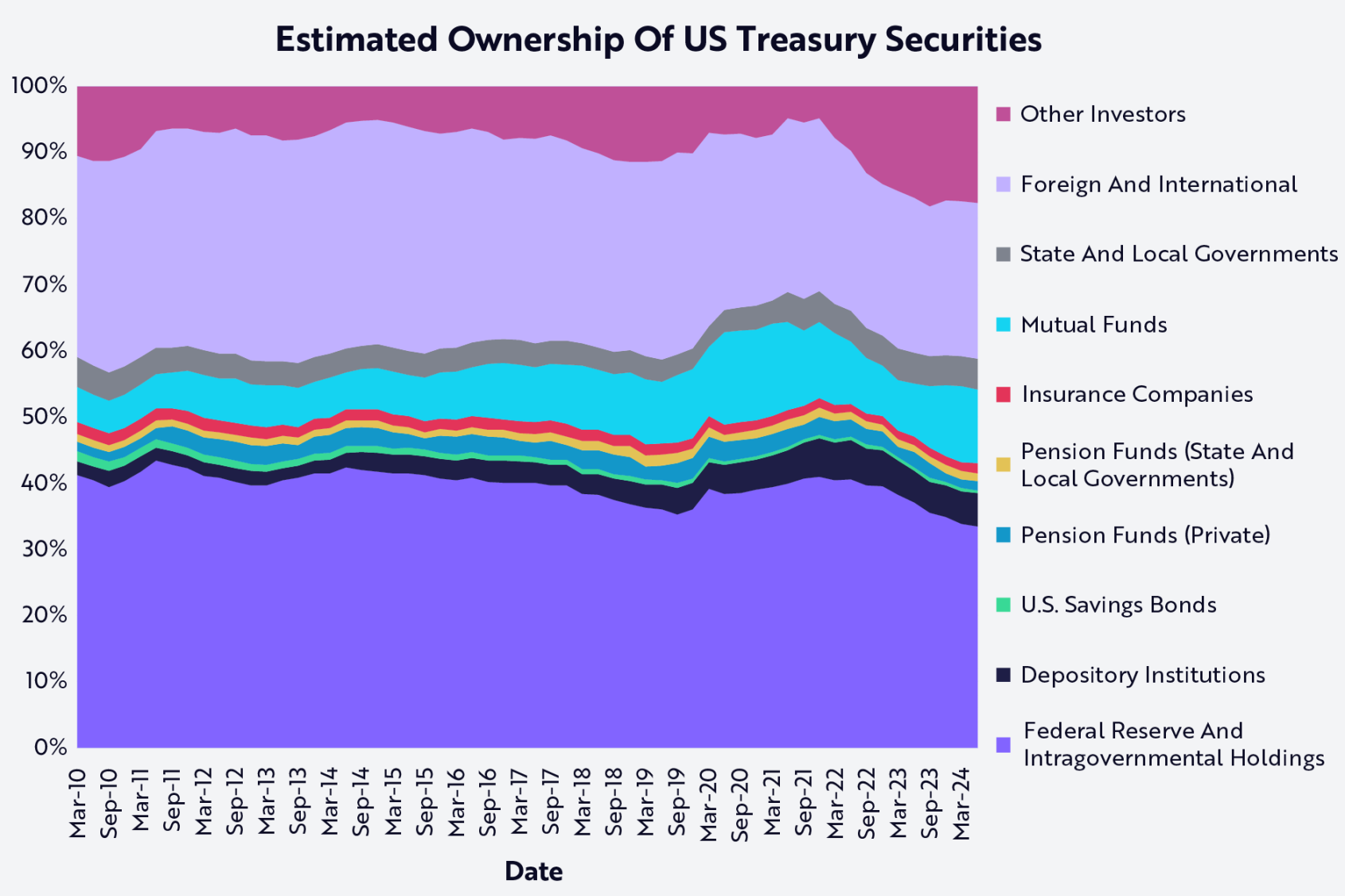
Data Source: ARK, as of May 28, 2025
The Federal Reserve is reducing its balance sheet through quantitative tightening, allowing maturing bonds to roll over without reinvestment. When the Federal Reserve sells U.S. Treasuries (or does not reinvest the proceeds from maturing bonds), the open market must absorb the supply of U.S. Treasuries, which, all else being equal, tends to push bond prices down and yields up.
The Federal Reserve is unlikely to restart U.S. Treasury purchases in 2025. On February 12, Chairman Powell reiterated, "We have a long way to go in reducing central bank bond holdings," explaining that there are no signs of liquidity deterioration in the market that would slow the quantitative tightening process. As of late February, the Federal Reserve was allowing approximately $25 billion in U.S. Treasuries and $35 billion in mortgage-backed securities to mature each month.
Meanwhile, the Congressional Budget Office predicts that the fiscal year 2025 deficit will reach $1.9 trillion, close to 6.4% of GDP. Over the next decade, the cumulative deficit could reach $20 trillion, meaning the U.S. Treasury will need to issue at least about $2 trillion in short-term, medium-term, and long-term bonds annually to finance government spending.
Despite the Trump administration's efforts to suppress long-term U.S. Treasury yields, in the absence of significant declines in inflation and real growth or new sources of demand for U.S. Treasuries, interest rates are more likely to rise. As demand from the largest holders of U.S. Treasuries continues to decline, and as the tariff war drives trading partners to significantly reduce their reliance on U.S. Treasuries, the increase in supply may overwhelm bond investors.
Can Tether and Circle take over the baton from China and Japan to boost demand for U.S. Treasuries?
In recent years, despite the Biden administration's negative stance on digital assets, the stablecoin market has continued to soar. Against the backdrop of extreme volatility in the cryptocurrency market, stablecoin issuers have quietly become one of the largest holders of U.S. Treasuries globally, as shown below:
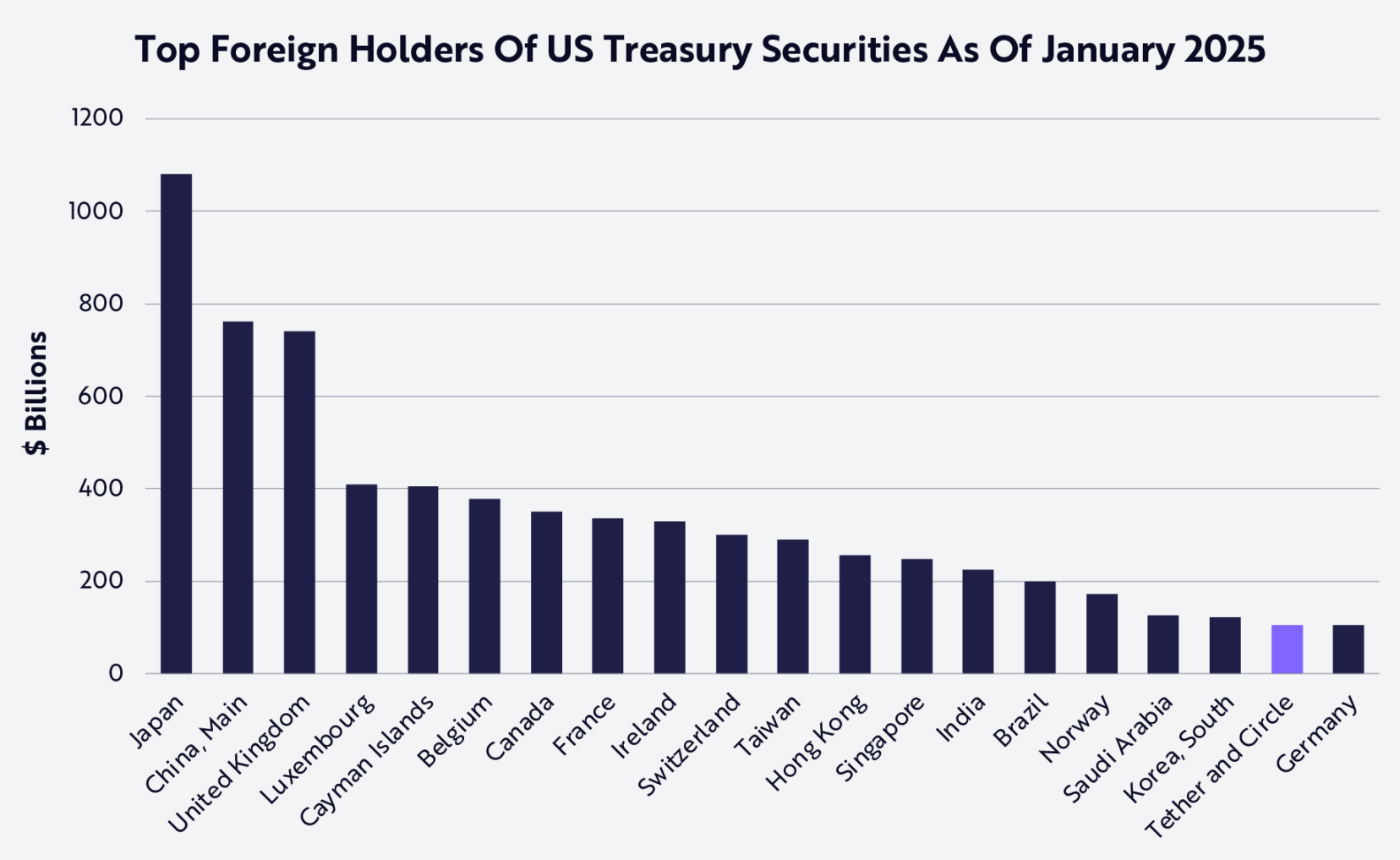
Data Source: ARK, as of May 15, 2025
On January 31, 2025, Tether's annual audit report revealed astonishing financial performance for 2024: an annual profit of $13.7 billion, with $6 billion earned in just the fourth quarter. Additionally, the company issued $23 billion in stablecoin USDT in the fourth quarter, with a total issuance of $45 billion for the year. As of the latest transparency report in March 2025, Tether currently holds $98 billion in U.S. Treasuries.
Meanwhile, as of late January, the second-largest stablecoin issuer, Circle, held over $22 billion in U.S. Treasuries. Together, Tether and Circle have become the 18th largest holder of U.S. Treasuries, trailing South Korea but surpassing Germany. Looking closely at 2024, Tether was the seventh-largest buyer of U.S. Treasuries (behind the UK and Singapore), while the largest sellers were China and Japan.
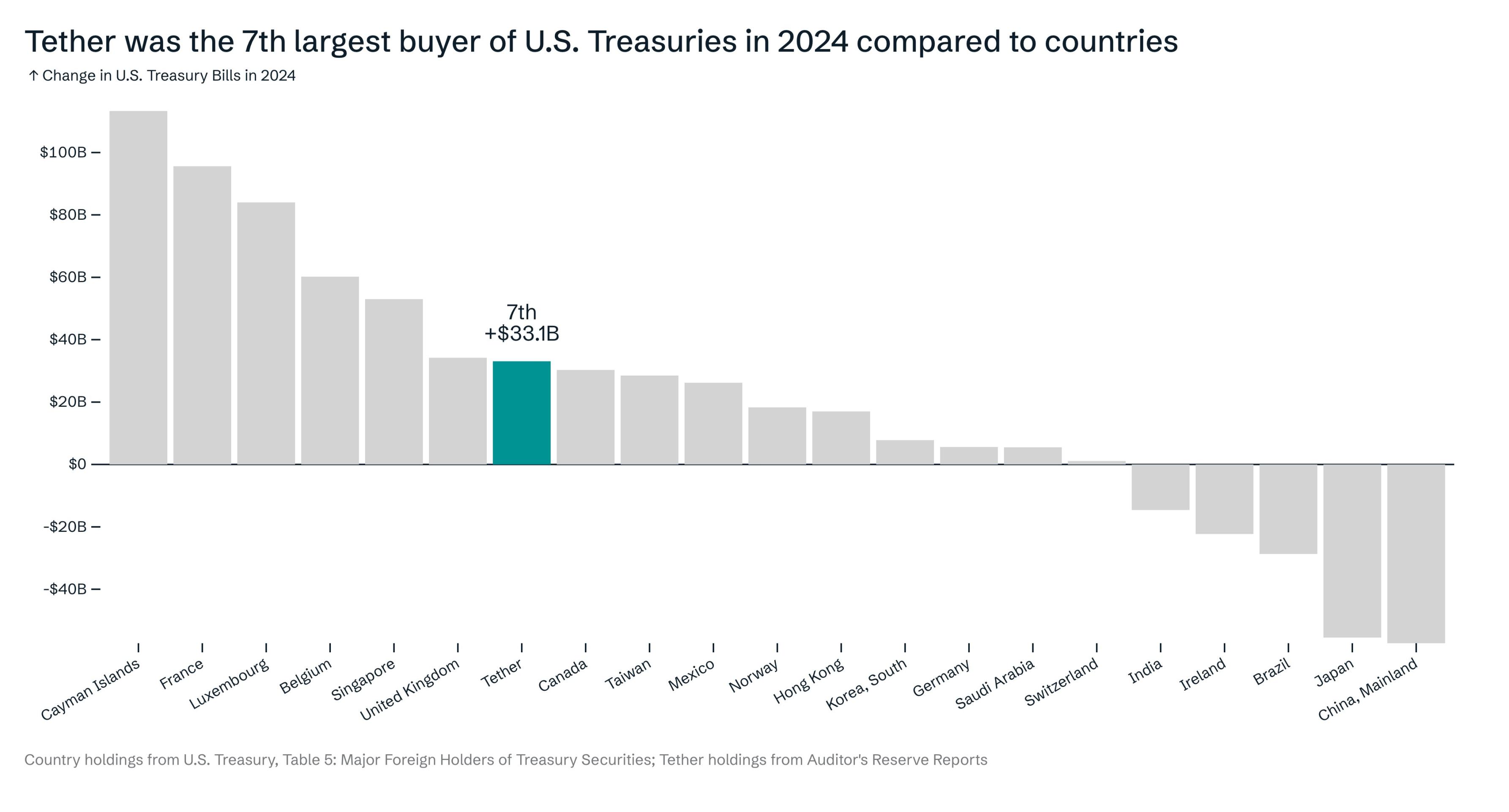
Data Source: Ardoino 2025, as of May 15, 2025
At the current issuance rate, we believe they are expected to surpass four to five countries by the end of the year.
In ARK's "Big Ideas 2025," we estimate that by 2030, the total supply of stablecoins could reach $1.4 trillion. If Tether and Circle maintain their current market share and allocation in U.S. Treasuries, they could collectively hold over $660 billion in U.S. Treasuries, close to China's current holding of $772 billion, only trailing behind China and Japan.
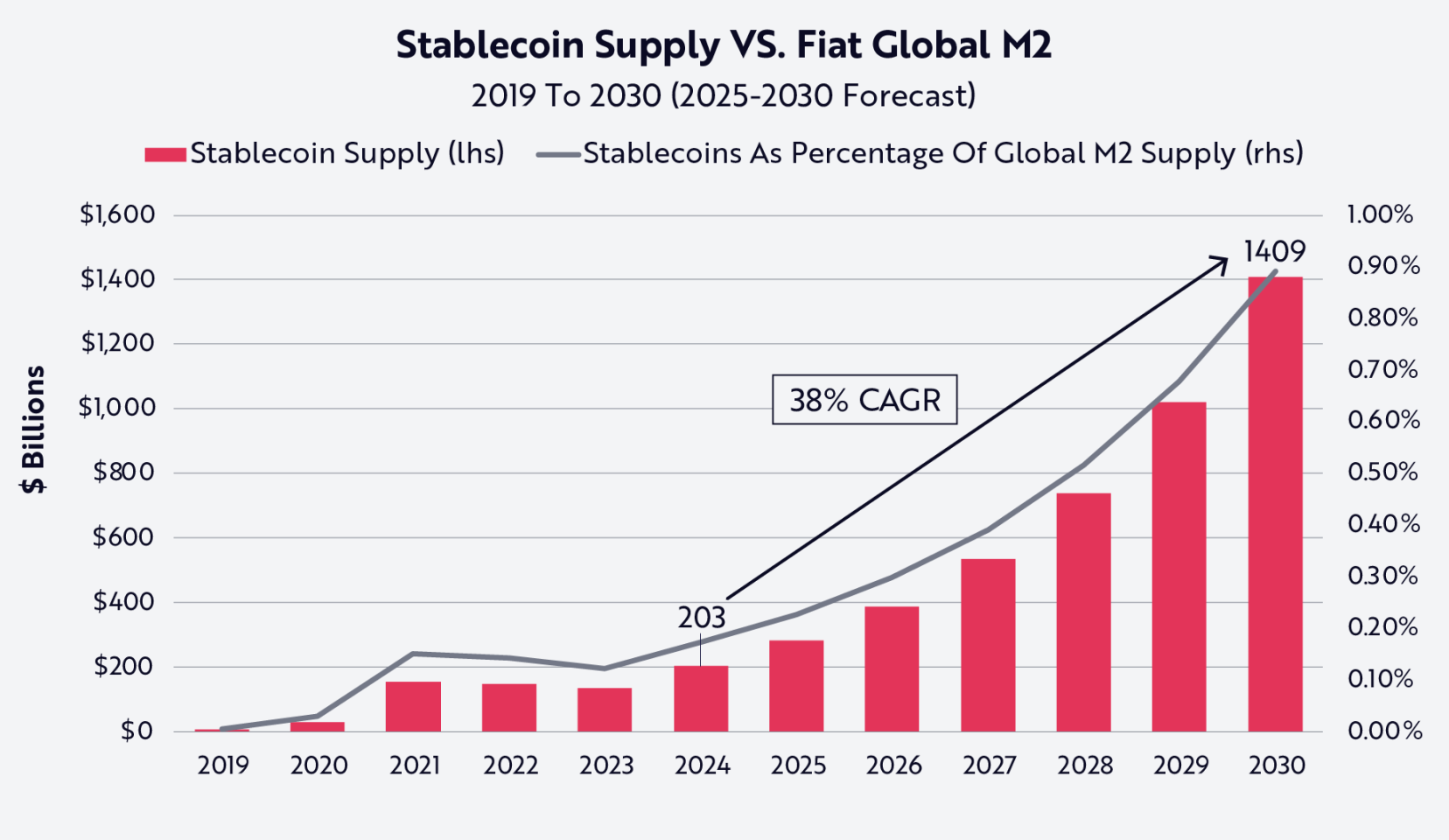
Data Source: ARK, as of December 31, 2024
Clearly, Tether, Circle, and the broader stablecoin industry may create one of the largest sources of demand for U.S. Treasuries in the coming years, potentially surpassing China and Japan as the largest holders by 2030. If this is the case, the stablecoin industry could make a significant contribution to lowering U.S. long-term interest rates.
Stablecoins can offset the impact of de-dollarization
The de-dollarization movement has two main objectives:
To remove the dollar's status as the world's reserve currency, especially as a pricing currency;
To prevent the flow of trade surplus funds into U.S. Treasuries.
Although efforts to replace dollar-denominated trade have made some progress in emerging markets, results have been limited in other regions. The war in Ukraine and sanctions against Russia have accelerated Moscow's push for BRICS countries (Brazil, Russia, India, China, South Africa) to bypass the SWIFT network and adopt alternative currencies and systems.
The group has expanded to BRICS+ (including Ethiopia, Iran, Saudi Arabia, and the UAE), clearly aimed at strengthening the alliance and promoting a new financial order.
In 2024, Putin launched the proposed "BRICS Bridge" international payment framework, aimed at further facilitating non-dollar transactions, but the initiative did not receive enthusiastic responses from other member countries, and its feasibility and implementation have been questioned.
Meanwhile, bilateral trade agreements in local currencies among BRICS countries and other emerging economies are becoming increasingly common, such as the latest agreements between India, China, Brazil, and Malaysia. About 50 years ago, the petrodollar agreement solidified the dollar's status as the primary pricing currency for global oil sales, and Russia's response to war-related sanctions marks the end of that agreement. According to Oilprice.com data, as of the end of 2023, 20% of global oil transactions are settled in other currencies, but these revenues often get converted back into dollars.
Despite many de-dollarization attempts yielding limited results, there is a harsh reality that cannot be ignored: in terms of GDP alone, the U.S. is no longer the world's largest economy. With the inclusion of Saudi Arabia, the UAE, Egypt, Iran, and Ethiopia, the BRICS+ group's GDP reached $29.8 trillion in 2024, slightly surpassing the U.S. GDP of $29.2 trillion.
Over the past two decades, the trend has been clear: BRICS+ economies are growing significantly faster than the G7, and all signs indicate that this change may continue.
Stablecoins hold a unique position in the evolving global financial landscape. They are the most liquid, efficient, and user-friendly "wrapper" for short-term U.S. Treasuries, effectively addressing the two major obstacles to de-dollarization: maintaining the dollar's dominance in global transactions while ensuring sustained demand for U.S. Treasuries.
In other words, whenever citizens of Argentina, Turkey, or Nigeria purchase stablecoins like USDT or USDC, they reinforce the dollar's status as the preferred pricing currency while creating demand for short-term U.S. Treasuries. Thus, stablecoins have become a "Trojan Horse" for U.S. Treasuries, ensuring ongoing (and even increasing) global demand for them.
Although the petrodollar agreement officially ended last year, similar tacit agreements are effectively forming and may be equally critical in the coming decades. If someone wants to purchase Bitcoin, Ethereum, or other digital assets outside the U.S., the dollar remains the required currency for most transactions on the world's most liquid exchanges. This financial moat has existed for over five years: dollar stablecoins (especially USDT) have been the primary trading pairs on major Asian exchanges like Binance, OKX, Upbit, Bybit, and Bithumb.
Taking Binance, the world's largest cryptocurrency exchange, as an example, its proof of reserves shows that among a token balance of $166 billion, customers hold over $34 billion in USDT and $6 billion in USDC. Dollar-denominated trades of cryptocurrencies like BTC, ETH, and SOL create significant demand for USDC and USDT overseas.
The rise of stablecoins as an internet-native dollar infrastructure
As of October 2024, Tether reported over 330 million on-chain wallets and accounts holding USDT, with 86 million held on centralized exchanges like Binance and OKX. In total, approximately 416 million wallets have interacted with USDT in some way.
Tether currently holds a 70% share of the total stablecoin market. Given its reported approximately 400 million addresses, it is reasonable to estimate that the number of addresses holding stablecoins globally is close to 570 million.
However, individuals and businesses typically use multiple wallets, and many addresses belong to exchanges or institutions that aggregate numerous users' funds into a single address. According to Chainalysis's 2024 report, about 30%-40% of addresses belong to individual users, meaning the number of individuals holding stablecoins globally is between 170 million and 230 million, a figure that aligns with other available data. For example, we know that approximately 40 million wallets are active each month, and it is estimated that 600 million people globally hold cryptocurrencies.
In this context, an interesting data point is to compare the number of stablecoin holders with traditional dollar holders (including cash and dollars in bank accounts):
Cash dollars: As of 2022, approximately $2.3 trillion in U.S. dollars were in circulation, with an estimated 50% held overseas. Assuming an average of $1,000 per person, about 1 billion people globally hold physical cash in dollars.
Electronic dollars: The Bank for International Settlements (BIS) reports that cross-border dollar liabilities amount to $12 trillion, including interbank transactions. Assuming one-quarter of this is held by households, that would be $3.2 trillion in personal dollar deposits. With an average balance of $5,000, approximately 640 million people globally hold dollar bank deposits.
Assuming half of the individuals holding digital dollars also hold cash dollars, there is an overlap of about 320 million people.

Data Source: ARK, as of December 31, 2024
In just over five years, stablecoins have reached approximately 200 million users globally, accounting for 15-20% of non-U.S. residents who hold dollars. Considering that the dollar has been in circulation for centuries, this is an astonishing achievement.
Given USDT's strong influence in emerging markets and its status as the largest stablecoin by supply, we can assume that USDT holders constitute a significant proportion of net new dollar holders, with a low overlap with cash dollars and dollar accounts.
Despite being misunderstood and criticized, stablecoins have undergone a dramatic transformation following the collapses of FTX and LUNA. In fact, the Trump administration, the new "crypto czar," and many legislators are praising stablecoins as strategic assets that effectively strengthen the dollar's global dominance by creating sustained demand for U.S. Treasuries. Therefore, Tether, Circle, and the entire stablecoin industry may evolve into one of the U.S. government's most reliable and resilient financial allies, ensuring long-term support for U.S. Treasuries while consolidating the dollar's position in global trade.
免责声明:本文章仅代表作者个人观点,不代表本平台的立场和观点。本文章仅供信息分享,不构成对任何人的任何投资建议。用户与作者之间的任何争议,与本平台无关。如网页中刊载的文章或图片涉及侵权,请提供相关的权利证明和身份证明发送邮件到support@aicoin.com,本平台相关工作人员将会进行核查。




